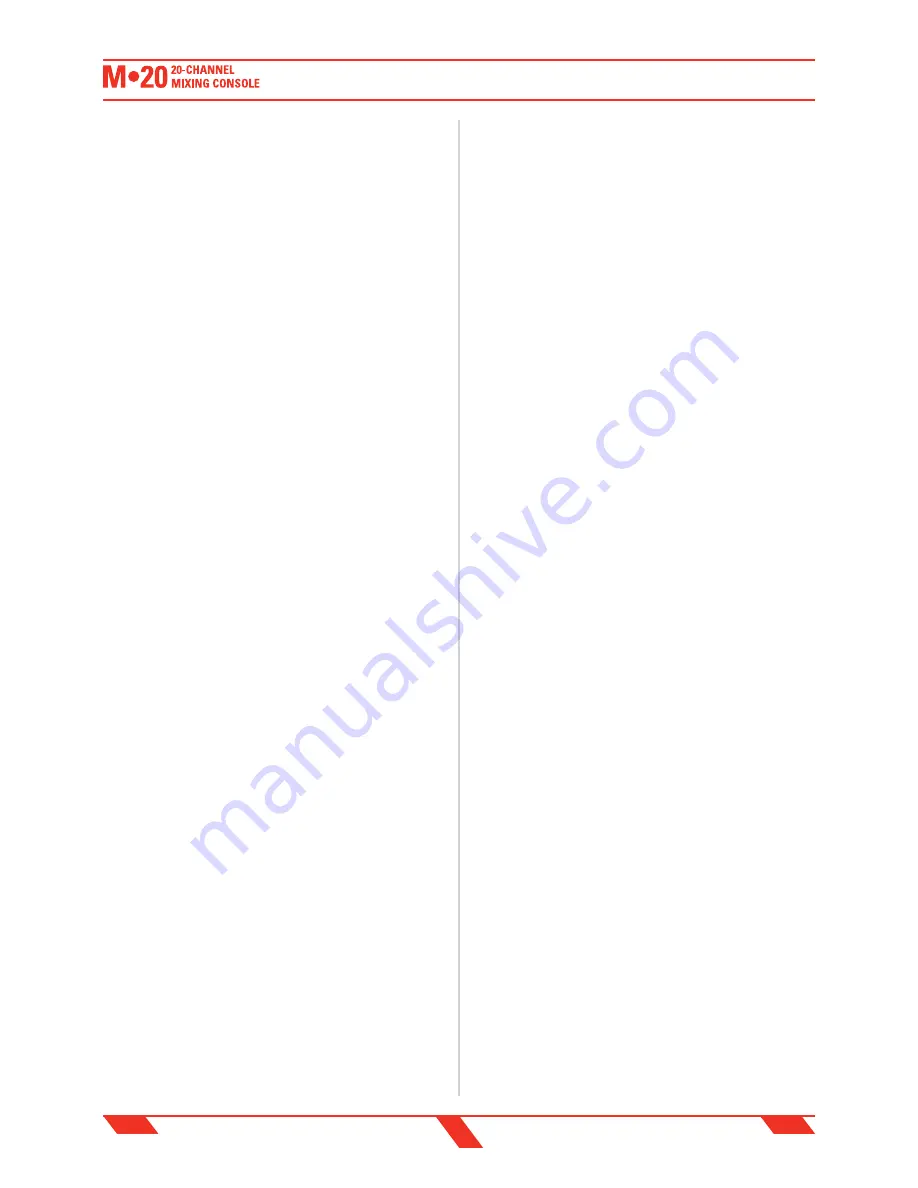
27
ENG
ITA
Set-up the M20USB for recording and monitoring yourself
when using a DAW software
1. Turn down:
the MAIN MIX (108) fader level,
the GROUP 1-2 / 3-4 (104) faders level,
the C.ROOM (81) / PHONES (80) knobs.
2. In your DAW software make sure to set record tracks WITHOUT
MONITORING during playback/recording (the method depends by your
DAW software).
3. Make sure these switches are UP:
2TRK TO MIX (74),
GROUP TO MIX (105)
MIX
(76)
otherwise you’ll hear feedback when you turn up the MAIN MIX fader
later.
4. Make sure these switches in the C.ROOM section are DOWN:
2
TRK
(79),
GRP 1-2 (77)
5. Connect the monitoring system to the C.ROOM (83) output or use the
headphones connected at PHONES (82) output.
6. Raise up a little the C.ROOM (81) / PHONES (80) knobs.
7.Set each recording channel’s GAIN (4)(26) knobs and LEVEL (22)(43)
fader so that you’re getting good level without lighting the PEAK indicator
on the mixer, also using the SOLO (21)(42) and SOLO MODE (113) PFL and
AFL operations.
8. Assign each channel both to MIX (17)(38) and 1-2 (18)(39) buses.
9. The MAIN MIX (108) fader now acts like a master recording level control
for all your mic/line inputs. Adjust this knob until you’re getting good
levels into your PC recording DAW software.
10. The GROUP 1-2 (104) fader now acts like a monitoring level control
for all your mic/line inputs, but it does not aff ect recording levels in your
PC.
11. The 2 TRK IN (73) knob now acts like a monitoring level control for all
pre-recorded playback tracks on your DAW software.
12. The C.ROOM (81) /PHONES (80) knobs now control the master
level of your studio monitors or headphones. You can set this level to a
comfortable setting, or even off without aff ecting what gets recorded.
Impostare l'M20USB per la registrazione sul PC
Mentre si invia un qualunque segnale ad un canale del mixer, mettete
in registrazione il software sul PC e regolate il livello del fader MAIN
MIX (108) per ottenere un corretto segnale di registrazione. Se il PC ha
un misuratore di livello, esso non deve mai raggiungere la zona rossa (0
dBFs) per evitare ogni distorsione da clip digitale.
Impostare l'M20USB per registrare, monitorando il
segnale quando si usa un software DAW
1. Abbassate al minimo:
il fader MAIN MIX (108),
il fader GROUP 1-2 / 3-4 (104),
la manopola C.ROOM (81) / PHONES (80).
2. Nel software DAW assicuratevi di impostare le tracce da registrare
SENZA IL MONITORAGGIO delle stesse durante la registrazione (il metodo
dipende dal software DAW).
3. Disattivate i tasti:
2TRK
TO
MIX
(74),
GROUP TO MIX (105),
MIX
(76)
altrimenti si otterrà un feedback (fi schio) quando dopo si alzerà il fader
MAIN MIX.
4. Assicuratevi che nella sezione C.ROOM/PHONES siano premuti i tasti:
2
TRK
(79),
GRP
1-2
(77)
5. Collegate il sistema di monitoraggio all'uscita C.ROOM (83) o usate
l'uscita per le cuffi e PHONES (82).
6. Alzate di un poco le manopole C.ROOM (81) /PHONES (80).
7. Impostate ogni guadagno di canale GAIN (4)(26) e fader di canale
LEVEL (21)(43) in modo da avere un buon suono senza accendere i led di
picco (PEAK) sul mixer, usando le funzioni SOLO (21)(42) e SOLO MODE
(113) PFL e AFL.
8. Terminata la regolazione dei livelli dei canali assegnateli sia al bus MIX
(17)(38) che al bus 1-2 (18)(39).
9. Il fader MAIN MIX (108) ora agirà come controllo generale di
registrazione per tutti gli ingressi mic/line. Regolatelo in modo da
ottenere un buon livello di suono nel programma di registrazione del
PC DAW.
10. Il fader GROUP 1-2 (104) ora agirà come controllo generale del
livello per il monitoraggio dei canali che si stanno per registrare, ma non
infl uenzerà il livello di registrazione nel PC.
11. La manopola 2 TRK IN (73) ora agirà come controllo generale delle
tracce in playback del software DAW.
12. Le manopole C.ROOM (81) / PHONES (80) ora agiranno come controllo
generale del livello sui monitor da studio o sulle cuffi e. Potrete impostarlo
ad un livello confortevole o addirittura spento senza influenzare la
registrazione.
USB INTERFACE
INTERFACCIA USB
Summary of Contents for M-20
Page 38: ...38 ENG ITA NOTE NOTE ...




























